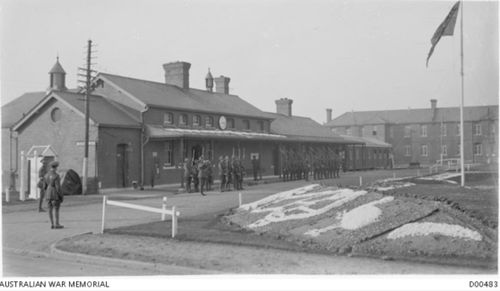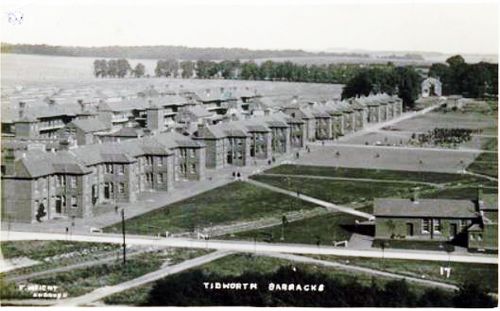Tidworth
From Our Contribution
 Changing the Guard - AIF HQs of Base Depots | |
 Existing brick barracks at Tidworth. | |
Contents
Remarks
The Camp was established when the British War Office acquired Tedworth House and large tracts of land to the north of the house in 1897.
Lucknow Barracks and Mooltan Barracks were completed in 1905, Tidworth Military Hospital was finished in 1907. Five more sets of barracks were added later. A Royal Ordnance depot was established during the First World War.
A branch from the Midland and South Western Junction Railway at Ludgershall was built in 1901 and opened to passengers in 1902. Goods tracks known as Tidworth Military Railway continued from Tidworth station into the military area.
Tidworth Military Cemetery was set up to serve the barracks. It includes the war graves of 417 Commonwealth service personnel of the First World War
Tidworth became the headquarters for the Australian Imperial Force in the UK from mid-1916, being close to the numerous Wiltshire camps where the Australians where based during the war. For most of 1919, HQ staff at Tidworth were busy in the repatriation of Australian troops, with at any one time up to 40,000 men in these Wiltshire camps. Tidworth Military Cemetery contains the graves of 159 Australians, many of whom died in the influenza epidemic during the winter of 1918-19.
The number of Australian troops in Britain, and the resulting need for support services, led to the creation of a large Australian military organisation in Britain. Command of Australian troops was divided throughout the war. The Administrative HQ in Horseferry Road in London was responsible for the administration of all of the AIF overseas, for medical services and for liaison with the War Office. AIF UK Depots at Tidworth Camp on Salisbury Plain was responsible for training, for the command depots and for discipline. The majority of the personnel of the training depots were men on six-month secondment from frontline units in France, but there were a substantial number of Australian personnel permanently based in Britain.
Unit Personnel
- Henry Richard Keefe 14 May 1918 - 11 Aug 1919 - 2 Command Depot cadre
Soldiers who passed this way
1916
- Edward Dudley Mann 24 Apr - 28 Aug 1916 - Pioneer Training Battalion
- Reginald Samuel Roquerbre Dutton 19 Jul - 20 Sep 1916 - Tunnellers training
- † Charles Stephen Haughey 14 Oct - 9 Nov 1916 - Signals Training
1917
- Alfred Martin Tilly 23 Mar - ?? Apr 1917 - 44th Battalion
- † George Alexander Armstrong 28 Mar - 18 Jun 1917
- Frederick Edwin Murphy 2 Apr - 25 Jul 1917 - Machine Gun Officers Training School
- † Stephen Hubert Christian (Hughie) Wallace ??Jun 1917 - SC Bombing School
1918
- George Henry Norman Pringle 21 Feb - 23 Mar 1918 - Australian School of Musketry
- † Rupert Gregg ?? Feb - 1 May 1918 - AIF HQs
- Henry Richard Keefe 14 May 1918 - 8 Jun 1919
- Albert George Bullock 28 May - 9 Jul 1918
1919
- Edward Stanley James 5 May - 24 Sep 1919
World War II
1940
- Raymond Eric Gerard Bennett 2/3rd Field Regiment (Artillery)
Notes
Any casualties not expected to return to duty within a month were evacuated to Britain. After treatment patients were discharged to various command depots and those not expected to be fit within six months were sent to Weymouth, whence they were repatriated to Australia.
Command depots were military units, and to conform with the new policy a depot at Bostal Heath, near Woolwich in southeast London, was placed within Lt Col. Sir Newton J. Moore’s command. The Anzac depot at Weymouth in Dorset was similarly reclassified and became Command Depot No. 2. The purpose of the command depots was to progressively improve the health of the sick or wounded man after his discharge from hospital, with the aim of returning him to active service.